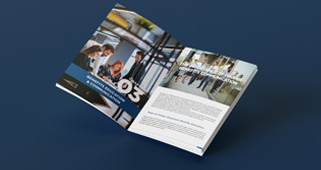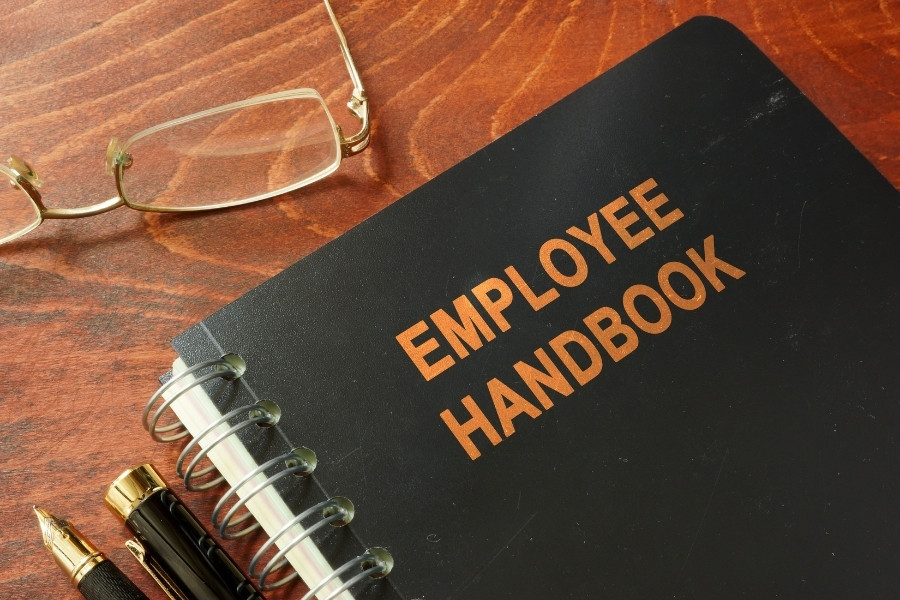All companies, regardless of size and industry, should have an employee handbook. Beyond offering insights about life at your company, handbooks outline how your business operates, everything you provide for your employees, and even offers some protection from a legal standpoint.
Accordingly, you’ll want to establish a foundational handbook before you even think about hiring your first employee. Think ahead to when your company grows; your future self will thank you for taking the time to get organized and create policies before things get out of hand.
With a well-written manual, everyone will be on the same page and can hold each other accountable. A good handbook might begin with explaining your company’s history, mission, values, and onboarding directions. Although interesting, likely the most read features of your manual will involve your company policies. Providing clear guidance for employees with necessary policies will reinforce the expectations as a new team member.
So, what policies should be included in an employee handbook? Here are five policies important enough to include in your handbook.
Five Policies to Include in an Employee Handbook
An employee manual is incomplete without some mention of company policies.
Without them, employees may be unclear of what is expected of them and what they should expect from you, their employer. Avoid any miscommunication by creating and maintaining the following policies from the beginning to hold employees accountable.
#1 Code of Conduct
A code of conduct is arguably the most important section to include in any employee handbook. Take advantage of this opportunity to establish boundaries and include policies that set your business up for continued success and a positive work environment. Even if they seem like common sense, be sure to mention the following topics to avoid any legal issues in the future:
- Anti-discrimination
- Anti-harassment
- Workplace safety
- Substance Abuse
- Disciplinary action
#2 Office Environment
Beyond the more serious necessities, an “office environment” section is your chance to give insight into an average day as a member of the team. Discuss things such as behavioral or attendance issues in this section.
- Work hours including lunch and breaks
- Dress Code
- Work from home policy
#3 Benefits
78% of employees reported they’re more likely to stay with an employer because of their benefits programs, meaning a well-explained benefits section is absolutely critical to acquiring and retaining top talent in your industry.
Use your benefits section to promote the list of benefits you provide to make your employees feel acknowledged and taken care of. Don’t forget to mention if your company has an eligibility period for certain benefits, or if certain types of employees, such as part-time, do not qualify.
- Health, disability, and/or life insurance
- Opportunities to contribute to an FSA or HSA account
- Retirement plans like 401(k)
- Leave policies for parental, bereavement, or jury duty
- Paid time off (PTO)
If you have yet to invest in an employee benefits program for your business or are looking to upgrade your offerings, this may be the motivation you need to finally pull the trigger. If you haven’t yet invested in employee benefits for your business, this may be the motivation you’re looking for to finally get it done and find the best benefits plan for you. Our team is always available to help, and our proprietary marketplace analysis saves businesses an average of 11% on their health insurance costs!
#4 Communications
Creating effective communication policies has always been incredibly valuable to our workplace environments. However, the way we communicate has and continues to evolve rapidly, making effective and respectful communication both easier and challenging in different ways.
If in the likely chance you provide your employees with some form of communication technology, such as phones or laptops, you should state your expectations on appropriate use. In addition, you should spell out policies on communicating with co-workers and/or clients through the following channels:
- Social Media
- Personal Phone Calls
- Instant Chat Features (ie, Teams, Google Meet)
#5 Performance and Pay
Your employees will likely revisit this section more than any other, so do not skip it! This will serve as a great way to document information about paychecks and performance evaluations to help motivate your employees.
- Pay periods
- Promotions and bonuses
- Overtime pay
- Travel expense policy
- Performance reviews
Get Your Employees to Read Your Manual
Even if you attempt to cover all bases by including every policy you can think of, no one will read it through if you write too many long-winded paragraphs littered with jargon or legal terms. Write concise sentences so you don’t lose the interest of your employees.
You know your business best, so use this manual to include top priority policies that make sense for you and your company’s size. For instance, you would want to include a workplace safety section if you’re a mid-sized manufacturer, but the same material might not be necessary for a small accounting office. Divide up your policy sections into subcategories if you want a certain policy to catch a team member’s attention.
Also, consider creating a digital handbook to make the material easier for employees to save for future reference. Using a digital format allows you to jump to the section you need to review by linking to each policy at the beginning of the document. Your employees are more likely to re-read the document if provided in an easily accessible format. After all, the goal is to have everyone read and understand the policies to create an optimal company environment.
Employee Handbooks Are Not A One-And-Done Project
Keep in mind your employee manual is an evolving document. Although you wouldn’t want to frequently make policy changes, you don’t have to have it all figured out from the start. Find relevant policies in the moment and add changes as you grow. If you’re looking for a place to get started, here are a few policies to include in your first edition below.
Benely: Your Number One Benefits Broker
Before you begin writing your employee handbook, you will need help establishing benefit offerings and HR solutions for your business. Take the confusion out of the process by allowing us to evaluate market options to find the most cost-effective solution for you.
Benely will shop, analyze, and personalize your group benefits in simple steps, all you need to do is make the final decision. We believe in commitment, growth, and technology all while providing you first-class personal experience and support.
Formerly known as Navali & Company, we have recently rebranded to be in line with our mission. We are now known as Benely, where benefits are done simply. Our name has changed, but the top-quality service we provide to our clients is still the same.
Contact us today to get started!






